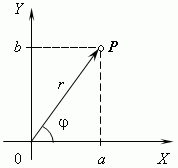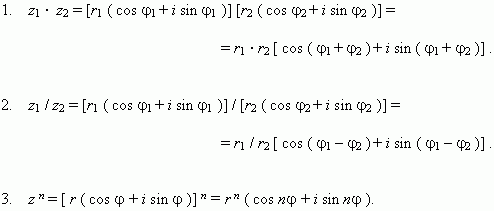Complex numbers
number. Conjugate complex numbers. Pure imaginary number. Pure
imaginary number. Operations with complex numbers. Geometric
representation of complex numbers. Complex plane. Modulus and
argument of a complex number. Trigonometric form of a complex
number. Operations with complex numbers in the trigonometric form.
Moivre's formula.
The initial information about imaginary and complex numbers has been presented above, in the section “Imaginaryand complex numbers”. A necessity of these new kind numbers has appeared at solving of quadratic equations in the case of D < 0
( D – a discriminant of a quadratic equation). During a long time these numbers had no physical applications, therefore they were called “imaginary” numbers. But now these numbers have various applications in different physical and technical fields, such as: electrical engineering, hydro- and aerodynamics, theory of elasticity and others.
Complex numbers are written in the shape: a+ bi . Here a and b – real numbers , and i – an imaginary unit, i.e. i 2 = –1. A real number a is called an abscissa of complex number a+ bi , and b – an ordinate of complex number a+ bi. Two
complex numbers a+ bi and a – bi are called the conjugate complex numbers.
Main agreements:
1. A real number a can also be written in the shape of a complex number: a+ 0 i or a – 0 i . For example, the records 5 + 0 i and 5 – 0 i mean the same real number 5 .
2. A complex number 0 + bi is called a pure imaginary number. The record bi means the same as 0 + bi .
3. Two complex numbers a+ bi and c+ di are considered as equal ones, if a=c and b=d . Otherwise, the complex numbers aren’t equal.
Addition. A sum of complex numbers a+ bi and c+ di is called a complex number ( a+ c ) + ( b+ d ) i. So, at addition of complex numbers their abscissas and ordinates are added separately. This definition corresponds to the rules of operations at usual polynomials.
Subtraction. A difference of two complex numbers a+ bi ( a minuend ) and c+ di ( a subtrahend ) is called a complex number ( a – c ) + ( b – d ) i. So, at subtraction of two complex numbers their abscissas and ordinates are subtracted separately.
Multiplication. A product of complex numbers a+ bi and c+ di is called a complex number: ( ac – bd ) + ( ad + bc ) i.
This definition follows from two requirements:
1) the numbers a+ bi and c+ di must be multiplied as algebraic bin omials,
2) a number i has a main property: i ² = – 1.
E x a m p l e . ( a+ bi )( a – bi ) = a ² + b ² . Hence it follows, that
a product of two conjugate complex numbers is a real positive number!
Division. To divide a complex number a+ bi ( a dividend ) by another c+ di ( a divisor ) means to find the third number e+ f i ( a quotient ), which being multiplied by the divisor c+ di , results the dividend a+ bi. If divisor isn’t equal to zero, then division is always valid.
E x a m p l e . Find ( 8 + i ) : ( 2 – 3 i ) .
S o l u t i o n . Rewrite this quotient as a fraction:
![]()
Multiplying its numerator and denominator by 2 + 3 i and
executing all operations, we’ll receive:

Geometric representationof complex numbers. Real numbers are represented by points in a numerical line:
![]()
Here a point A means a number –3, a point B – a number 2, and O – zero. In contrast this complex numbers are represented by points in a “numerical” ( coordinate ) plane. For this we select a system of rectangular ( Cartesian ) coordinates with the same scale in both axes. Then, a complex number a+ bi will be represented by point P with abscissa a and ordinate b ( see figure ). This coordinate system is called a complex plane .

___
Modulus of a complex number is a length of vector OP , representing this complex number in a coordinate( complex ) plane. Modulus of complex number a+ bi is signed as | a+ bi | or by letter r and equal to :
![]()
Conjugate complex numbers havethe same modulus.
___
Argument
of a complex number is the angle
![]() between
x
-axis and vector
OP
, representing this complex number.
between
x
-axis and vector
OP
, representing this complex number.
![]()
Trigonometric form of a complex number.
Abscissa
a
and ordinate
b
of the
complex number
a + bi
can be expressed by its modulus
r
and argument
![]() :
:

Operations with complex numbers, represented in the trigonometric form.

This is the famous Moivre’s formula.
![]()
Here k is any integer. To receive n different values of the n -th degree root of z it’s necessary to give n consecutive values for k ( e.g., k = 0, 1, 2,…, n – 1) .